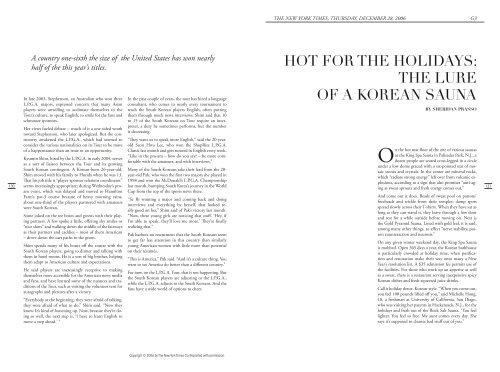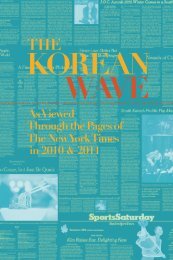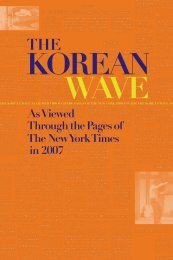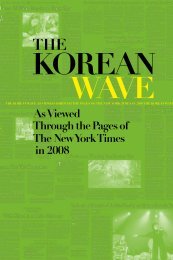The Korean Wave 2006 - Korean Cultural Service
The Korean Wave 2006 - Korean Cultural Service
The Korean Wave 2006 - Korean Cultural Service
You also want an ePaper? Increase the reach of your titles
YUMPU automatically turns print PDFs into web optimized ePapers that Google loves.
<strong>The</strong> New York Times, thursday, december 28, <strong>2006</strong><br />
g3<br />
130<br />
A country one-sixth the size of the United States has won nearly<br />
half of the this year’s titles.<br />
In late 2003, Stephenson, an Australian who won three<br />
L.P.G.A. majors, expressed concern that many Asian<br />
players were unwilling to acclimate themselves to the<br />
Tour’s culture, to speak English, to smile for the fans and<br />
schmooze sponsors.<br />
Her views fueled debate -- much of it a one-sided wrath<br />
toward Stephenson, who later apologized. But the controversy<br />
awakened the L.P.G.A., which had seemed to<br />
consider the various nationalities on its Tour to be more<br />
of a happenstance than an issue or an opportunity.<br />
Kyumin Shim, hired by the L.P.G.A. in early 2004, serves<br />
as a sort of liaison between the Tour and its growing<br />
South <strong>Korean</strong> contingent. A <strong>Korean</strong>-born 26-year-old,<br />
Shim moved with his family to Florida when he was 13.<br />
That his job title is “player-sponsor relations coordinator”<br />
seems increasingly appropriate; during Wednesday’s proam<br />
event, which was delayed and moved to Hamilton<br />
Farm’s par-3 course because of heavy morning rains,<br />
about one-third of the players partnered with amateurs<br />
were South <strong>Korean</strong>.<br />
Some joked on the tee boxes and greens with their playing<br />
partners. A few spoke a little, offering shy smiles or<br />
“nice shots” and walking down the middle of the fairways<br />
as their partners and caddies – most of them American<br />
– drove down the cart paths to the green.<br />
Shim spends many of his hours off the course with the<br />
South <strong>Korean</strong> players, going to dinner and talking with<br />
them in hotel rooms. He is a sort of big brother, helping<br />
them adapt to American culture and expectations.<br />
He said players are increasingly receptive to making<br />
themselves more accessible for the American news media<br />
and fans, and have learned some of the nuances and traditions<br />
of the Tour, such as visiting the volunteer tent for<br />
autographs and pictures after a victory.<br />
“Everybody at the beginning, they were afraid of talking,<br />
they were afraid of what to do,” Shim said. “Now they<br />
know. It’s kind of loosening up. Now, because they’re doing<br />
so well, the next step is, ‘I have to learn English to<br />
move a step ahead.’ ”<br />
In the past couple of years, the tour has hired a language<br />
consultant, who comes to nearly every tournament to<br />
teach the South <strong>Korean</strong> players English, often putting<br />
them through mock news interviews. Shim said that 10<br />
to 15 of the South <strong>Korean</strong>s on Tour require an interpreter,<br />
a duty he sometimes performs, but the number<br />
is decreasing.<br />
“<strong>The</strong>y want us to speak more English,” said the 20-yearold<br />
Seon Hwa Lee, who won the ShopRite L.P.G.A.<br />
Classic last month and gets tutored in English every week.<br />
“Like in the pro-am – how do you say? – be more comfortable<br />
with the amateurs, and with interviews.”<br />
Many of the South <strong>Korean</strong>s take their lead from the 28-<br />
year-old Pak, who won the first two majors she played in<br />
1998 and won the McDonald’s L.P.G.A. Championship<br />
last month, bumping South Korea’s journey in the World<br />
Cup from the top of the sports news there.<br />
“Se Ri winning a major and coming back and doing<br />
interviews and everything by herself, that looked really<br />
good on her,” Shim said of Pak’s victory last month.<br />
“Now, these young girls are noticing that stuff. ‘Hey, if<br />
I’m able to speak, they’ll love me more.’ <strong>The</strong>y’re finally<br />
realizing that.”<br />
Pak harbors no resentment that the South <strong>Korean</strong>s seem<br />
to get far less attention in this country than similarly<br />
young American women with little more than potential<br />
on their résumés.<br />
“This is America,” Pak said. “And it’s a culture thing. You<br />
want to see America do better than a different country.”<br />
For now, on the L.P.G.A. Tour, that is not happening. But<br />
the South <strong>Korean</strong> players are adjusting to the L.P.G.A.,<br />
while the L.P.G.A. adjusts to the South <strong>Korean</strong>s. And the<br />
fans have a wide world of options to cheer.<br />
Hot for the Holidays:<br />
<strong>The</strong> Lure<br />
of a <strong>Korean</strong> Sauna<br />
By SHERIDAN PRASSO<br />
On the hot mat floor of the one of various saunas<br />
at the King Spa Sauna in Palisades Park, N.J., a<br />
dozen people are seated cross-legged in a circle<br />
under a low dome graced with a six-pointed star of mosaic<br />
stones and crystals. In the center are mineral rocks,<br />
which “radiate strong energy” left over from volcanic explosions,<br />
according to a sign that also promises “anti-aging<br />
as sweat sprouts and fresh energy comes out.”<br />
And come out it does. Beads of sweat pool on patrons’<br />
foreheads and trickle from their temples; damp spots<br />
spread slowly across their T-shirts. When they have sat as<br />
long as they can stand it, they leave through a low door<br />
and rest for a while outside before moving on. Next is<br />
the Gold Pyramid Sauna. Lined with gold leaf, it is said,<br />
among many other things, to affect “nerve stability, poison<br />
counteraction and neurosis.”<br />
On any given winter weekend day, the King Spa Sauna<br />
is mobbed. Open 365 days a year, the <strong>Korean</strong> bathhouse<br />
is particularly crowded at holiday time, when purification<br />
and restoration make their way onto many a New<br />
Year’s resolution list. A $35 admission fee permits use of<br />
the facilities. For those who work up an appetite as well<br />
as a sweat, there is a restaurant serving inexpensive spicy<br />
<strong>Korean</strong> dishes and fresh-squeezed juice drinks.<br />
Call it holiday detox, <strong>Korean</strong>-style. “When you come out,<br />
you feel 100 pounds lifted off you,” said Michelle Hong,<br />
18, a freshman at University of California, San Diego,<br />
who was visiting her parents in Hackensack, N.J., for the<br />
holidays and fresh out of the Rock Salt Sauna. “You feel<br />
lighter. You feel so free. My aunt comes every day. She<br />
says it’s supposed to cleanse bad stuff out of you.”<br />
131<br />
Copyright © <strong>2006</strong> by <strong>The</strong> New York Times Co. Reprinted with permission.





